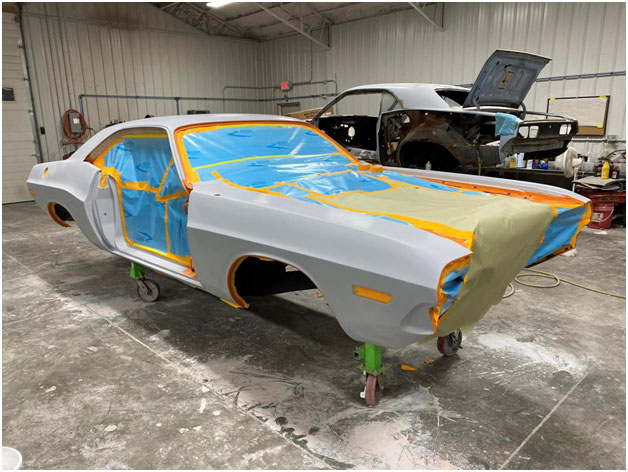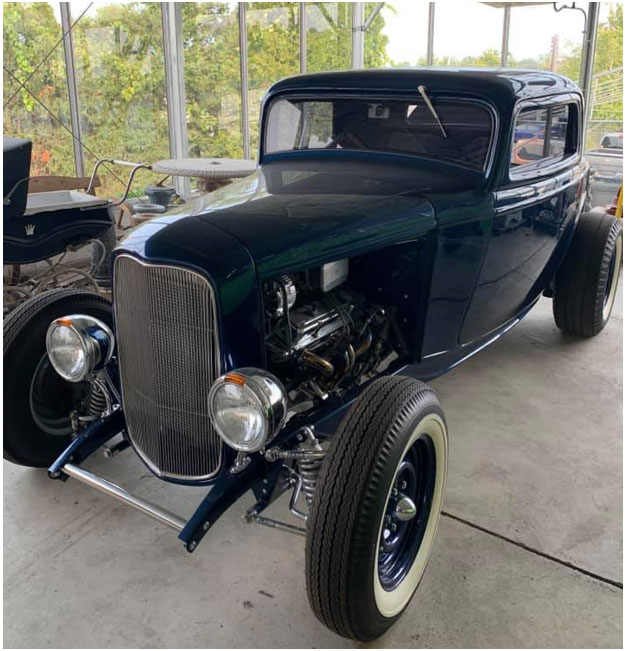
Image by Menands Classic Cars
Classic Car Restoration: Tips and Tricks for a Successful Project
Classic cars hold a special place in the hearts and memories of car enthusiastsaround the globe. Their timeless beauty, historical significance, and nostalgia make them an enjoyable hobby. Restoring a classic car allows you to bring it back to its former gloryand offers the thrill of driving a piece of automotive history.
Embarking on a classic car restoration project requires commitment and dedication. A full restoration involves disassembling the car, addressing mechanical and cosmetic issues, and reassembling it to original or improved condition.
Classic car restoration is not a quick or easy task. Prepare for the challenges you’ll have during the restoration, such as finding rare or discontinued parts, encountering mechanical issues, or dealing with bodywork and paint.

Image by Menands Classic Cars
Overview of Car Restoration:
The restoration process can be divided into several stages:
- Tear-down.
- Bodywork.
- Mechanical Restoration.
- Interior Restoration.
- Painting and Finishing.
- Troubleshooting and Final Touches.
Each stage requires specific skills, tools, and attention to detail. By understanding the overall process, you can plan and execute your restoration project more effectively.
Choosing the Right Classic Car:
When choosing the right classic car for restoration, here are three key factors to keep in mind:
- Sentimental Value:Sentimental value can provide a sense of connection and personal fulfillment.
- Historical Significance:Classic cars often have historical significance, and restoring a historically significant vehicle can also enhance its value and desirability in the future.
- Ease of Restoration:Consider your skill level, your experience, and the resources you have available.
Setting Up Your Restoration Workshop:
Creating a well-equipped and organized workshop is crucial for a successful restoration project. Here are two key aspects to consider when setting up your restoration workshop:
• Tools Required:Hand tools and specialized tools are needed to complete your restoration. Tools such as wrenches, socket sets, screwdrivers, and pliers are essential for disassembly and reassembly. Specialized tools may include engine hoists, welders, paint sprayers, and diagnostic equipment.
• Space Considerations:Having adequate space in your workshop is vital for maneuvering around the car, storing parts, and setting up your tools and equipment. Consider your ventilation, lighting, and electrical outlets when designing your workshop space.
Safety Protocols:Safety should always be a top priority in any restoration project.
• Personal Protective Equipment (PPE):Make an investment in your own personal protective equipment by purchasing items like as safety glasses, gloves, and ear protection. Respirators or face masks may be necessary if you’re sandblasting, welding, sanding, or painting.
• Proper Ventilation:Ensure that your workshop has adequate ventilation to minimize the inhalation of toxic fumes or harmful chemicals. If you work with paints, solvents, or other hazardous substances or chemicals, always use them in a well-ventilated area or use proper extraction systems.
• Fire Safety:Have fire extinguishers readily available in your workshop and know how to use them. Avoid working with flammable materials near open flames or other potential ignition sources. Regularly inspect your electrical systems and wiring to prevent fire hazards.
Inspection and Assessment:
Before diving into the restoration process, always inspect and assess the car's condition. This step allows you to identify areas needing attention and determine how much restoration is required. Here are key areas to inspect and assess:
• Body:Carefully examine the car's body for signs of rust, corrosion, dents, or other damage. Check the structural integrity of the frame and body panels. Inspect the condition of the paint, chrome trim, glass,and weatherstripping.
• Interior:Assess the interior components, including the seats, carpeting, dashboard, headliner, and door panels. Look for any tears, fading, or wear and determine if the original upholstery needs replacement. Check the functionality of switches, gauges, and controls.
• Mechanical Components:Inspect the engine, transmission, suspension, brakes, and other mechanical systems. Check for leaks, cracks, signs of wear, and any damage to vital components. Evaluate the condition of the exhaust, cooling, and fuel systems. Assess the electrical system, including wiring, lights, and other accessories.
Gauging the Extent of Restoration Needed:Once you have completed the inspection, it's time to gauge the extent of restoration required. This assessment helps you prioritize tasks, allocate resources, and create a restoration plan. Consider the following factors:
• Cosmetic Restoration:Evaluate the cosmetic aspects of the car, such as the bodywork, paint, and interior. Determine if it requires a full paint job or if small touch-ups will suffice. Assess the level of upholstery repair or replacement needed. Identify areas that require refinishing or re-chroming of trim pieces.
• Mechanical Restoration:Does the engine require rebuilding, or does it only need minor repairs? Evaluate the condition of the transmission, suspension, brakes, and other systems. Determine if replacement or refurbishment of certain parts is necessary.
Creating a Restoration Plan:
A restoration plan outlines your goals, timelines, budget, and priorities. Define the level of restoration you would like to achieve, whether it's a complete restoration or just making the car drivable. Divide the project into smaller tasks, prioritizing them based on criticality and dependencies.
Stripping and Bodywork:
Begin by stripping the car of its old paint and removing any rust. This process may involve sanding, media blasting, or chemical stripping. Repair or replace damaged body panels to ensure a solid foundation for the next steps.
Mechanical Restoration:
Addressing the mechanical components is crucial for the car's performance and reliability. Evaluate and repair the engine, transmission, suspension, and braking systems. Ensure all electrical systems are functioning and replace worn-out parts with new or refurbished components.
Interior Restoration:
The interior of a classic car deserves special attention. Upholstery, dashboards, seats, and carpets may need refurbishing or replacement. Use special care when selecting materials that match the car's original design. Install replacement parts, such as knobs and handles, to restore functionality and aesthetic appeal.
Final Assembly and Finishing Touches:
Carefully reassemble all the parts, ensuring they fit correctly and function smoothly. This stage requires meticulous attention to detail and patience.
Paintwork and Polishing:
A professional paint job is a lot of work. It means applying multiple layers of primer, base coat, and clear coat for a smooth and durable finish. Choose a color that complements the car's original design or history.
Regular Servicing and Cleaning:
Schedule regular servicing to keep your car in optimal running condition, including oil changes, filter replacements, and general maintenance tasks. Regularly wash and wax the exterior and clean the interior to maintain its appearance.
Storing the Vehicle Properly:
When your classic car is not in use, proper storage is essential to protect it from environmental elements. Store it in a dryenvironment to prevent rust, mold, and deterioration. Use a car cover to shield it from dust and UV rays. Consider investing in a battery maintainer to keep the battery charged during long periods of inactivity.
Joining a Classic Car Community:
One of the joys of classic car restoration is being part of a community of enthusiasts who share your passion. Joining a car club or online community offers several benefits. You can connect with like-minded individuals, share restoration tips and advice, and find valuable resources and contacts for parts and services. Networking within the classic car community provides a wealth of knowledge and support, making your restoration journey even more enjoyable.
Conclusion: The Joy of Restoring Classic Cars
Restoring a classic car is a journey that requires dedication, skill, and a deep appreciation for automotive history. From understanding the intricacies of the process to choosing the right car, setting up a workshop, and carrying out each stage with precision, you can breathe new life into a classic automobile.
So, embrace the challenge, enjoy the process, and let the restoration of a classic car become a fulfilling and rewarding experience that will continue to bring you joy for years.
As you invest your time and effort into restoring every intricate detail of your beloved classic car, it's equally important to safeguard your hard work. Consider securing comprehensive classic car insurance from experts like Leland West, who understand the unique value and significance of these automotive treasures. Classic car insurance not only offers financial protection but also preserves the legacy you've meticulously revived.
Frequently Asked Questions:
FAQ 1:How much does classic car restoration cost?
The cost of classic car restoration can vary significantly depending on many factors.The make and model of the car you choose, its condition it is in, the amount of work required, and the availability of new and used parts will all affect your budget.
FAQ 2:How long does classic car restoration take?
It can take several months or even years to complete a full restorationdepending on many factors.For example, if you only have weekends available, it will take longer. Set realistic timelines based on the specific requirements of your project.
FAQ 3:Can I restore a classic car by myself?
If this is your first restoration, it may be helpful to seek guidance from experienced restorers, attend workshops or classes, or join a classic car community where you can learn from others and gain valuable tips and insights.
FAQ 4:Where can I source parts for my classic car?
Start by checking with specialized classic parts suppliers, salvage yards, and online marketplaces that cater to classic car enthusiasts. Attending swap meets and auctions can also provide opportunities to find unique parts for your restoration project.
FAQ 5:How can I learn more about classic car restoration?
Read books and publications to learn restoration techniques, tips, and case studies. Online platforms, including websites, forums, and social media groups, offer a wealth of information and opportunities to connect with experienced restorers and enthusiasts.
Sources:
https://classicsworld.co.uk/guides/12-best-beginners-tips-for-classic-car-restoration/
https://www.owatrolusa.com/automobile/classic-car-restoration/
https://www.hemmings.com/stories/article/26-restoration-tips
https://techtalk.mpbrakes.com/classic-car-restoration-guide
https://www.escalontimes.com/209-living/classic-car-restoration-tips-beginners/
https://magazine.northeast.aaa.com/daily/life/cars-trucks/antique-car-restoration/
https://www.adrianflux.co.uk/blog/2019/05/classic-car-restoration-tips.html
https://panoramanow.com/classic-car-restoration-essential-skills-for-beginners/
